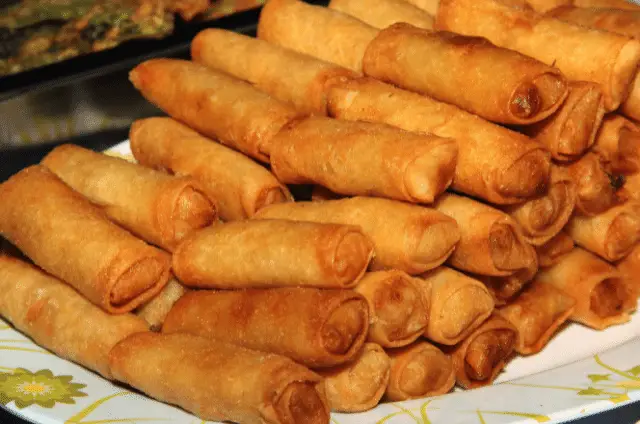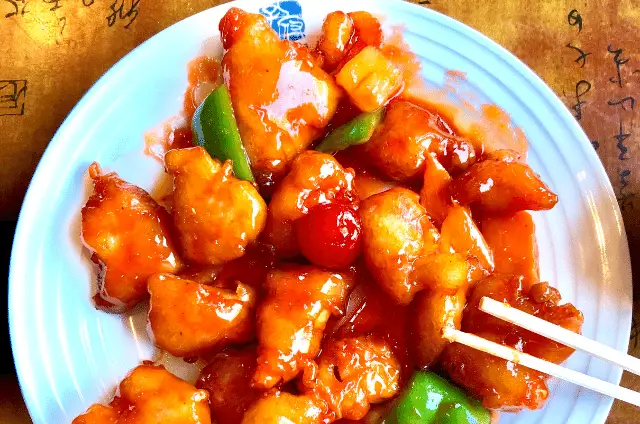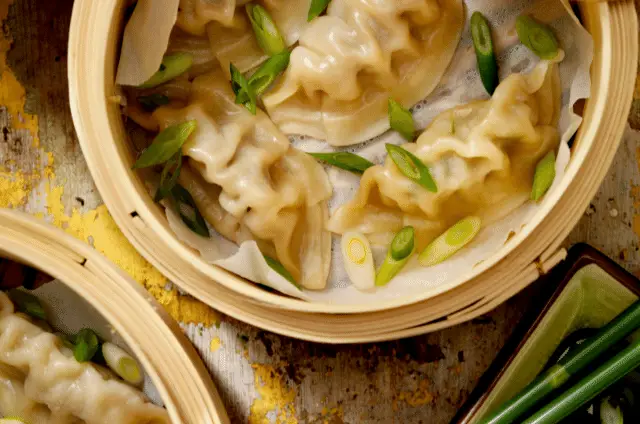You might’ve heard through the rumor mill that there are certain foods and ingredients imported from China that should be avoided for some health reason or another. You might have also heard that certain Chinese food dishes might be high in sodium and fat, and thus avoided for dietary reasons. You might be wondering… is any of that true!? And if so, what should you avoid?
There are a surprising number of foods, ingredients, and imports from China that one ought to avoid for health reasons. This article looks at the 20 main foods and ingredients from China you should avoid. Additionally, you’ll learn some of the more famous, caloric Chinese food dishes to avoid, and the dishes that are healthier to eat instead.
Chinese Products & Ingredients to Avoid
Not every import, food product, or ingredient that comes from China is bad. That would be unfair and unjust to say, as some products are perfectly safe, consumable, and cancer-concern free. However, it is true that there are quite a few food products that come from China that should be avoided due to very real health concerns. Read below to acquaint yourself with the foods and ingredients from China you should avoid.
Tilapia & Cod

This white, flaky fish may be delicious, but it appears on most food and medical blogs as one of the food products from China that should best be avoided. More than 80% of the tilapia that is sold in North America is shipped from China. Unfortunately, Chinese Tilapia are farm-raised and subsequently pumped full of GMOs and antibiotics.
Likewise, over half of all the cod shipped to the US is from China. Chinese Cod is also farm-raised and full of GMOs and have endured similarly questionable practices as that of Chinese Tilapia.
There have been actual FDA (Food & Drug Administration) and Center for Food Safety reports that discovered at least 50% of these farm-raised Chinese Tilapia were fed animal feces. Yes. Animal poop. Disgusting! Why fish farmers would feed excrement to fish, we have no idea. Though, the absurd amount of antibiotics the fish are given suddenly makes more sense…
The main takeaway is that:
- Tilapia and cod are being farm-raised, treated inhumanely, and being pumped full of growth hormones and should be avoided for the sake of your health.
- Be sure to check the labels on your grocery store Tilapia to make sure it says “freshly caught” or “wild-caught” and that it is imported, not from China, but from a country whose food practices are more regulated.
- When the transparency in the US fish supply chain seems murky, best to avoid these two types of fish altogether just to be safe.
Chicken

Perhaps one of the most shocking food practices is that some U.S poultry suppliers actually export their U.S domestic grown chickens to China to be processed (i.e.: pumped full of antibiotics and growth hormones) and shipped BACK to the United States. Why would U.S suppliers go to such lengths? Because in 2013, the USDA actually approved the sale of GMO (hormone and antibiotic filled) chickens into the U.S from foreign countries.
If you’re sitting there thinking, ‘why ship chickens already raised in the U.S to another country, just to ship them back?’ That is because Chinese meat factories do not have USDA inspections (or at least are not required to provide such inspections) and thus there is truly no way to supervise what is being done to the chickens (what they are eating, what hormones or antibiotics they’ve been given, and how they’re being treated).
Additionally, China is pretty infamous for its poor treatment of animals in factories. Unfortunately, most mass-produced meat industries, even in the US, do not hold up under scrutiny when it comes to the fair and humane treatment of animals.
Since factory workers are paid low wages, work long hours, and work in grueling conditions, there is no additional motivation to ensure the animals in such factories are treated well (when the humans working in these scenarios aren’t even being well looked after.) On the whole, it is best to avoid any poultry that is shipped from China to ensure you are not endorsing animal cruelty, and aren’t ingesting hormones & antibiotics.
Apple Juice
It doesn’t surprise many people when they are told to stay away from meats from China, however, it does surprise most people when they learn that apple juice is a far bigger health threat. If you ever buy generic, cheap, or even mid-range label apple sauce or apple juice, chances are you are purchasing a product from China.
China imports around 370 million+ gallons of apple juice to America each year. When put through testing, traces of arsenic, miscellaneous chemicals, and toxic pesticides were found in Chinese-made apple juice! Additionally, these questionable apple juice products are colored with corn syrup, so there is virtually no nutritional value at all.
Industrial Salts
When purchasing salt for your home or business, it is best to stay away from any industrial salts shipped from China. Chinese-made industrial salts have been known to contain a type of sodium that causes hypothyroidism and reproductive health issues and is not actually fit for human consumption.
Mushrooms
While the majority of Chinese mushrooms arrive in the form of canned goods, more and more Chinese mushrooms, like shiitakes, are finding a home at local grocery marts all across the U.S. This wouldn’t be an issue, of course, if some of those mushrooms weren’t found to have illegal pesticides on them! While the majority of Chinese mushrooms are probably safe for consumption, especially if you properly wash any and all mushrooms you purchase from a store. However, to be safe, still locally grown mushrooms.
Watermelon
Similar to imported Chinese Shiitake mushrooms, Chinese grown watermelons have also been found with illegal pestiside residue. The reason Chinese watermelons are so enormous is in large part to the hormones and additives they endow the watermelons with. However, these are not chemicals you want in your body (as growth hormones of that nature can cause cancerous cell growth.)
Corn
It would be easy to assume most corn products in the United States are from the United States, as corn feels like an all-American staple. However, some canned corn does come from China, and these products have been found to contain sodium cyclamate, to exude that gorgeous yellow color. Unfortunately, sodium cyclamate is as toxic as its name suggests: it can cause massive liver damage if consumed. Fortunately, sodium cyclamate has been banned from the U.S and hundreds of other countries across the globe.
Chinese Tea
Imports of tea products from China have been found to contain 29 different toxic chemicals. Now, not all tea from China has pesticides and other such chemicals, but those teas which are mass-produced likely do. It is crucial you do your research on where your teas come from.
Additionally, it is best to purchase only organic, locally grown teas, where you can visit the tea farms or gardens to assess for yourself how they were made before you steep your dry pesticide leaves in boiling water and consume all the chemicals leached from the leaves.
Garlic
You might recall a large garlic recall that occurred some years back, in 2015, when over 130 million pounds of garlic, some even labeled ‘organic,’ were discovered to have been bleached to prevent the garlic from sprouting. These recalled garlic bulbs were also disinfected with methl bromide – a very bad toxin that can cause serious respiratory and central nervous system damage. In fact, this kind of disinfectant has only ever been used on sewage…yet for some reason, Chinese garlic suppliers were using it on human garlic?
- Warning: while we talk about looking for only products with an ‘organic’ label, it’s as important to know that foreign countries’ stamp of ‘organic’ is rather meaningless. Only products locally grown in the US, with an ‘organic’ label can be trusted as organic.
- Even then, to be absolutely sure there’s utter transparency, you’d need to contact the manufacturer of that ‘organic’ labeled food product to ensure there wasn’t some shady business where the product is shipped from China, but labeled and put out in the U.S.
Rice Noodles

Some rice noodles have been found with traces of sulfur dioxide, to make the noodles seem fresh. Sulfur dioxide is a chemical that has been linked to cancer cell production and should not be consumed by humans. Therefore, we recommend getting your rice noodles from Japan, instead of China.
Chinese Cabbage
Apparently, summer temperatures are a real challenge for some Chinese cabbage farmers, as the high temps threaten their crops. So, some farmers in China spray their cabbage with a super toxic chemical called formalin, to keep the cabbages looking healthy. However, no human on earth should be eating formalin. Therefore, stay away from Chinese cabbage!
Eggs
On the whole, you’d be better off purchasing locally hatched eggs, to begin with, but you should know there have been eggs imported from China that had calcium carbonate and paraffin in them. These chemicals, if ingested, can cause serious stomach issues, resulting in food poisoning or worse.
Wine
If it’s too good to be true… it probably is. Some wines may look deliciously purple-red, however, a peek at the label might help discern whether that is due to the true color of well-grown grapes, or due to food dyes or artificial flavorings. Chinese wines have been known to add sugar, dye, and flavor to their wines. Best to refrain!
Chinese Dishes to Avoid
The following meals are ones Kathleen M. Zelman, MPH, from Web MD has suggested are best to avoid on a health level. There is nothing shady or necessarily toxic about these dishes, they are simply high in sodium, fat, and calories which make them meals you might want to avoid.
Egg Rolls

Egg rolls are seriously delicious. Why? Because they are deep-fried dough poles you dip in sugar sauce! One tiny egg roll is around 220 calories, 10 grams of fat, and a few dunks of dipping sauce can equal 2 tablespoons of sugar! Eat too many of these and you won’t just feel exhausted from the heavy oils and fats, your heart will be working overtime! If you are a person with any heart concerns, it’s best to stay away from these delicious fried appetizers.
Sweet and Sour Pork

Sweet and sour pork is delicious because it is literally caked in sugar. How much sugar exactly? About 16 teaspoons worth of sugar. That is more than three chocolate bars! Not only that, but this Chinese food dish is essentially just battered deep-fried meat. If you were to eat an entire entrée of sweet and sour pork, you’d consume over 1,000 calories and more than 48 grams of fat!
General Tso’s Chicken

(check it out: the origins of American Chinese food)
The only thing worse than sweet and sour pork is General Tso’s chicken. This battered, deep-fried chicken dish is similarly coated in a sugar sauce. Some General Tso chicken recipes have been known to be over 1,500 calories and over 88 grams of fat. That’s nearly all your allotted calories and fat for the day in one single meal.
What Dishes to Enjoy, Instead
Now that you know which Chinese food meals to avoid, here’s a list of foods that are healthier options, so you can still enjoy your favorite cuisine without feeling guilty or concerned for your health!
Steamed Veggie Dumplings

Dumplings may be made with a thin noodle dough, but when packed full of veggies and leafy greens, as well as when steamed, these can make for a relatively healthy dish! If you are looking to cut back on sodium, you can even swap out the soy sauce for chili pepper sauce, or a coconut amino sauce!
Soups

Most Chinese food soups (egg drop, wonton, hot and sour) are safe to eat. These meals are usually low in calories and help fill your stomach with broth, making you less likely to purge on other, unhealthier Chinese food options. There may be a good amount of sodium in these soups, but they are comparable to other Chinese food dishes, and certainly not the most sodium-rich foods on most Chinese restaurant menus.
Past Cases of Chinese Food Fraud
This link brings you to the post: what kind of meat does Chinese food restaurant use
In addition to general types of factory-produced foods to avoid from China, there have been several cases of food fraud from China in the last several years. You might want to avoid the following products as well since they have been involved in fraud and scandal.
Plastic Rice
Just when you think you’ve heard everything… there’s plastic rice. Chinese authorities have apparently made several search and seizure raids in the past from criminals passing off fake rice as the real thing. Their concoction? A mix of potatoes, sweet potatoes and industrial resin. Resin you say? Yes. A resin used to make plastic.
Chinese authorities were able to discern the difference between the false rice and real rice, because the counterfeit product stayed hard when cooked and wasn’t easy to digest. Which makes sense… since it was made with plastic.
Soybeans & Green Peas
In 2010 a surplus of reports surfaced surrounding peas and soybeans from China. People were finding ‘fake peas’ in their batches of purchased soybeans or green peas. Turns out snow peas were being mixed with food coloring and sodium metabisulfite (a toxic chemical) in order to make them appear like Chinese green peas (or soybeans.)
Lamb
In 2013, Chinese Authorities arrested 900 individuals for selling lamb meat that was actually spoiled rat meat. So nasty. The Chinese police officers confiscated 20,000 POUNDS of this rancid vermin meat. So…yeah… maybe don’t eat lamb from China either.
Cooking Oil
The fraud continues! A large food supplier in China was found guilty of recycling used olive oil from thousands of restaurants, filtering it, and reselling it. You have to go through a lot of effort to ask establishments to loan you their used, rancid oil. Filter that used oil and resell it. Oil, which is fat, goes rancid very easily…especially when the oil has already been used for cooking and now contains other mysterious food elements (like meat juice, etc.)
Best to avoid purchasing olive oil from China as well.
Is it Possible to Avoid Chinese Food Products?
It is possible to avoid Chinese food products, however, it will be a challenge. As you continue on your educational journey surrounding where your food comes from and how it is made, you are likely to discover just how many products are shipped to U.S soil from China. However, certain grocery marts, like Whole Foods, Lassens, and Sprouts, specialize in healthier, more locally-grown food options.
The best places to source your produce and meats is from local farmers. Not only can you better discern where the food is coming from, but many local farmers will allow persons to tour their farms to assess for themselves how their food is being processed. Not only that, but you cut down on your carbon footprint by endorsing local businesses, who did not have to ship their produce on planes, boats, and big rigs, but rather from their farm to the farmers’ market.
